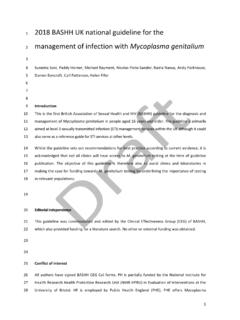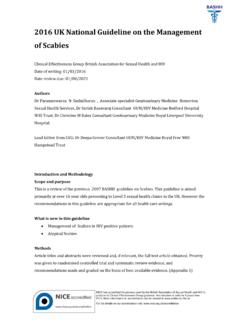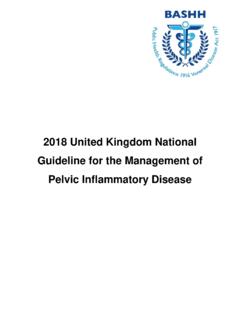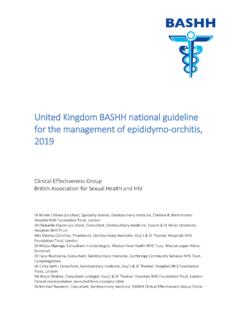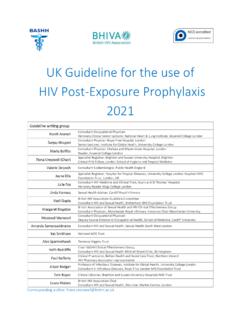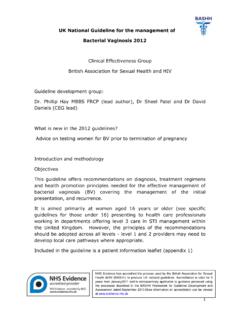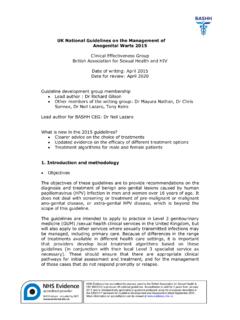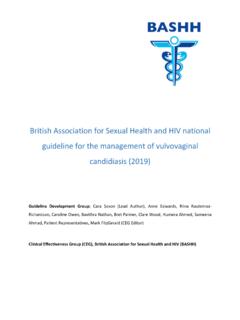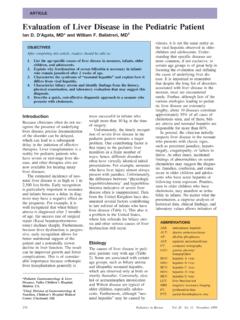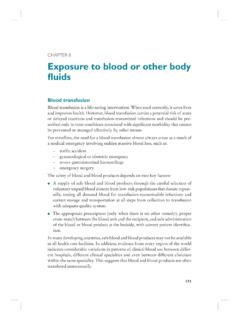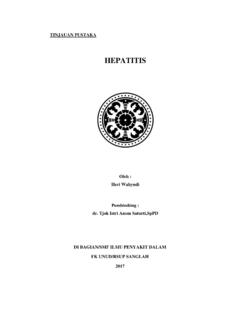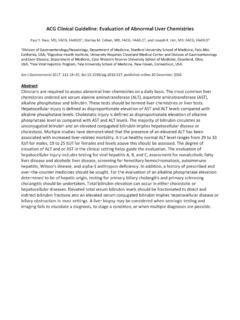Transcription of 2017 interim update of the 2015 BASHH National Guidelines ...
1 1 2017 interim update of the 2015 BASHH National Guidelines for the Management of the Viral Hepatitides This guideline is an interim update of the 2015 Guidelines to reflect recent changes in epidemiology, testing and treatment. We have added new advice on hepatitis A testing and vaccination in response to the recent HAV outbreak in MSM, updated the definition of chronic hepatitis B and advice on vaccination of HIV+ patients. We have also updated advice on hepatitis C testing and treatment. This is accompanied by expansion of the relevant background sections in the main text (sections 2-5). Changes to the 2015 guideline are highlighted in yellow. This update was performed by a small subgroup of the 2015 writing committee but using the same methodology as below. Introduction and Methodology for the 2015 guideline This guideline is an update of the guideline published in 2008 and, like its previous version, provides guidance for best practice in the diagnosis, management and prevention of viral hepatitis types A, B and C.
2 It is primarily intended for use in UK Genitourinary Medicine (GUM)/Sexual Health settings, but can be applied or adapted for use in other settings where sexually transmitted infection (STI) assessments are undertaken such as in integrated STI/contraception sexual health services and other specifically commissioned services, including general practice. This guideline is for use by all healthcare professionals (doctors, nurses and health advisers) and for use when dealing with patients who are attending with symptoms that may be attributed to a STI, with concern about STIs or are requesting screening for STIs. It will also be useful to managers and commissioners of sexual health services in understanding service needs. The purpose of the guideline is to help improve the sexual health of individuals attending sexual health clinics by encouraging high standards of care.
3 The guideline offers recommendations on best practice regarding viral hepatitis for both men and women, including adolescents. The guideline is predominantly based on what a broad range of clinicians believe constitutes reasonable practice, based on best evidence. Evidence is sometimes cited from non-UK sexual health settings and from other settings outside sexual health care where necessary. The recommendations/evidence are graded using the GRADE system (appendix). Search Strategy This document was produced in accordance with the guidance set out in the Clinical Effectiveness Group s (CEG) document Framework for guideline development and assessment at The 2015 2 guideline updates the previous guideline by searching Medline 2008-2014 for hepatitis A , hepatitis B , hepatitis C , hepatitis D and Delta virus and limited to human and English . The Cochrane database was searched for hepatitis A , hepatitis B , hepatitis C , hepatitis D and Delta virus .
4 The 2010 European (IUSTI/WHO) guideline on the management of viral hepatitis , the 2017 European Association for the Study of the liver (EASL) Guidelines for the management hepatitis B and the 2014 European Association for the Study of the liver (EASL) Guidelines for the management hepatitis C, the 2014 British HIV Association (BHIVA) Guidelines for the management hepatitis viruses and the 2014 American Association for the Study of Liver Disease (AASLD) Recommendations for Testing, Managing, and Treating hepatitis C were reviewed. In addition, sections on hepatitis in relevant BASHH and other Guidelines were reviewed for other references. Forward and backward searching from key references was also conducted. Piloting and Feedback The writing committee includes clinicians from the specialties of GUM, hepatology, infectious diseases, microbiology, nursing and sexual health advising.
5 Prior to publication, the final draft of the guideline was placed on the British Association for Sexual Health and HIV ( BASHH ) website for a two month consultation period and copies were circulated to the Genitourinary Nurses Association (GUNA) and the Society of Sexual Health Advisers (SSHA) chairs for comment and peer review. It was also reviewed by the BASHH Public Panel. The guideline was piloted before it was finally ratified. Abbreviations used in these guidelinesALF: Acute liver failure ALT: Alanine transaminase ALP: Alkaline phosphatase APRI: AST to platelet ratio ART: Antiretroviral therapy AST: Aspartate transaminase Anti-HBc: antibody against hepatitis B core antigen Anti-HBe: antibody against hepatitis B e antigen Anti-HBs: antibody against hepatitis B surface antigen DAA: Direct acting antiviral agents EASL-CPG: European Association for the Study of the Liver clinical practice guideline ELF: Enhanced liver fibrosis score FIB-4: Fibrosis 4 score HAV: hepatitis A virus HBsAg: hepatitis B surface antigen HBeAg: hepatitis B e antigen HBIG: hepatitis B Immunoglobulin HBV: hepatitis B virus HBV-DNA: hepatitis B virus deoxyribose nucleic acid HCC: Hepatocellular carcinoma HCV: hepatitis C virus HCV-RNA: hepatitis C virus ribose nucleic acid HDV: hepatitis D virus HEV: hepatitis E virus HNIG.
6 Human normal Immunoglobulin IgG: Immunoglobulin type G IgM: Immunoglobulin type M LFT: Liver function test MSM: Men who have sex with men NEAT: European AIDS Treatment Network PCR: Polymerase chain reaction PT: Prothrombin time PWID: People who inject drugs STI: Sexually transmitted infection Contents 1 Key Recommendations Acute hepatitis 3 hepatitis A Which asymptomatic patients should be screened for evidence of past HAV infection in the sexual health setting? What to do if the HAV total antibody test is negative in the asymptomatic patient. What if the patient is found to have acute hepatitis A? What to do if a patient presents as a contact of a patient with acute hepatitis A. What to do if there is a hepatitis A outbreak in MSM. hepatitis B Which asymptomatic patients should be screened for evidence of past /current hepatitis B infection in the sexual health setting? What if the asymptomatic patient is not immune to hepatitis B?
7 What if the patient is found to have acute hepatitis B? What if the patient is found to have chronic hepatitis B? What to do if a patient presents as a contact of a patient with hepatitis B. hepatitis C Which asymptomatic patients should be screened in the sexual health setting? What to do if the at-risk patient is HCV non-infected. What if the patient is found to have acute hepatitis C? What if the patient is found to have chronic hepatitis C? What to do if a patient presents as a contact of a patient with hepatitis C. Main text: 2. hepatitis A Aetiology Transmission hepatitis A Outbreak in the UK and Europe 2016-17 Incubation Period Symptoms Signs Complications Diagnosis Serology Other tests Management General Advice Further Investigations Acute icteric hepatitis Pregnancy and Breast Feeding Sexual and Other Contacts Follow-Up Screening and Primary Prevention 3.
8 hepatitis B 4 Aetiology Transmission Incubation Period Symptoms Signs Complications Diagnosis Table: hepatitis B Serology Biochemistry Management General Advice Further Investigations Acute icteric hepatitis Treatment of Chronic Infection Pregnancy and Breast Feeding Sexual and Other Contacts Follow-Up Screening and Primary Prevention Screening Figure: Flow chart for hepatitis B screening using serum anti-HBc Figure: Flow chart for hepatitis B screening using serum HBsAg Primary prevention Table: Vaccination Schedules for hepatitis B hepatitis D (Delta virus infection, HDV) 4. hepatitis C Aetiology Transmission in the UK: Incubation period Symptoms Signs Complications Diagnosis Serology Other Tests Management General Advice Further Investigations Treatment Figure: NEAT Algorithm for the management of Acute HCV and Breast Feeding Sexual and Other Contacts Follow-Up Screening and Primary Prevention 5.
9 Resource implications 6 Qualifying statement 7. Auditable Outcomes 8. Conflicts of interest 5 9. References Appendix: The GRADE system 1 Key Recommendations Acute hepatitis What to do if a patient presents with symptoms suggestive of acute viral hepatitis . Clinically assess the patient and if necessary refer for hospital admission(1A) section Perform tests to assess the severity of the hepatitis including LFT, clotting, and hepatitis serology (including HAV IgM, HBsAg, HCV antibodies/antigen/RNA and HEV serology/PCR) (1B) section Inform the appropriate public health authority, for contact tracing (1C) section hepatitis A asymptomatic patients should be screened for evidence of past HAV infection in the sexual health setting? In the sexual health setting, the hepatitis A virus total antibody test can be offered to at-risk patients whose immune status is unknown and who do not have a definite history of a completed HAV vaccination course, depending on local funding arrangements and risk of patient not returning for vaccination.
10 (2B) section In an outbreak situation or if the patient may not return, antibody testing should not prevent the administration of the first vaccine dose on the same day as testing. The patients to be targeted are: MSM, PWID, HBV+, HCV+ and HIV+ patients (1B) section HAV screening should not be offered to patients who are known to be immune or fully vaccinated (1B) section What to do if the HAV total antibody test is negative or the antibody test is not done in the asymptomatic patient. In at-risk patients (all MSM attending a sexual health clinic, PWID, HBV+, HCV+ and HIV+ patients) offer a course of hepatitis A vaccination with either the mono-dose vaccine (or the combined hepatitis A and B vaccine if non-immune to both infections) and no documented evidence of previous hepatitis A vaccination (1B) section Discuss safer sex and how to reduce risk of catching this infection (1D) section if the patient is found to have acute hepatitis A?
